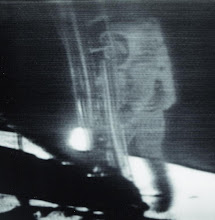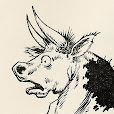



One of the most arresting sights in a garden or landscape is the bottle tree. All are alike, but no two are the same. Some consist solely of blue bottles; some have great variety in the size, shape and color. It's rare for me to see one, since I don't get out into the countryside too much. But there's no telling where they'll show up - in fact, the one shown here was located in a dense urban neighborhood. The strand of Christmas lights is an unusual embellishment.
The story is that bad spirits are irresistibly drawn into them, become trapped and can't enter the house to do harm. Most people, including some scholars, believe them to be an African survival, first employed by slaves. The great American writer Eudora Welty, while working for the W.P.A. in the 1930s, took the black and white photo in Simpson County, Mississippi. She also wrote about bottle trees in her short story "Livvie."
The boldly painted Clorox bottle in the last picture was done by Mary T. Smith, a well-known African American folk artist from Mississippi. She made several of these spirit traps. It was given to me by a friend during a rough time in my life. I never put it outside.


















































